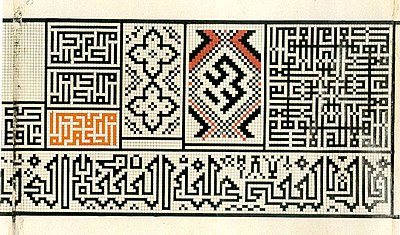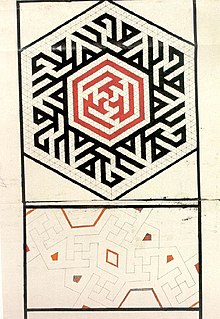Topkapı role

The Topkapı Scroll ( Turkish Topkapı Parşömeni ) is a parchment scroll from the Timurid period in the collection of the Topkapı Palace Museum in Istanbul . A mark on the roll "H1956" indicates that the roll was registered there in the inventory of the Treasury.
The scroll contains 114 drawings of geometrically constructed patterns that may have served as a template and pattern book for architects and artists, especially for wall coverings with quasi-crystalline patterns made from ceramic Girih tiles .
description
The scroll is 33 cm wide and 29.5 m long and written in landscape format. One end of the roll is attached to a wooden stick, and at the other end there is a protective leather strip.
A number of pieces of parchment with various pattern drawings are glued to the roll. The different margins of individual drawings suggest that the scroll was composed of at least two different works. It is not worn, so it is believed that it was intended as an exhibit for the Sultan's Palace rather than as a reference book for artisans. It may have been used to document work that had been carried out on the palace.
It is believed that the scroll was made by a single person. Most of the pattern drawings were drawn on two pieces of parchment which were then glued together on the roll. The sample drawings are mixed up, because drawings with related topics are sometimes far apart. Some of the patterns recorded on two sheets of parchment are not glued together properly.
Origin and rediscovery
The Topkapı scroll was probably made in Persia during the Safavid period , at the end of the 15th or beginning of the 16th century. Pattern similarities between the images on the scroll and a tile surface in the Great Mosque in Yazd suggest that the scroll could have been made in Tabriz . Alternatively, Shiraz would also come into question, because the muqarnas in the form of a fan, as shown on the scroll, was called "Shirazi" (from Shiraz) by Jamshid Masʿud al-Kashi . The scroll may have reached Istanbul as booty from the Ottoman – Safavid War (1578–1590) .
In 1986 the scroll was found again in Topkapı Palace.
content

|

|
|
|
Left picture : Quarter-dome muqarnas in shell (above) and radial fan shape (below) from the Topkapı
scroll.Right picture : Great Mosque of Yazd , Iran, 14th century. |
||

The scroll contains 114 geometric patterns of decorative elements, drawn with ink and ink, as they were often used on walls and in domes of the Timurid period. These are patterns as they appear in the architectural elements of Muqarnas , Girih , and mosaic surfaces . Some of the fan-shaped muqarnas depicted on the scroll are typical of the Timurid architectural style , other muqarnas in shell shapes are more like Cairo . The role does not contain any information on how these patterns are constructed or how the two-dimensionally depicted patterns can be transferred to three-dimensional building structures. It is neither dated nor signed.
Other illustrations show Islamic calligraphy in the Kufic style. A prime example of Kufic writing is often seen in ornaments made in the banna'i technique ( Persian بنائی, 'Structural Engineering'). With this technique, glazed tiles and simple masonry bricks are placed alternately in a wall and create a geometric pattern. Such ornaments have been found on existing structures. Some of the patterns give typical examples of geometrically constructed Islamic calligraphy: On one illustration, the name Mohammed (Muḥammad ibn ʿAbd Allāh) is inscribed six times on the outer edge of a hexagon, while the name Ali ( ʿAlī ibn Abī Tālib ) appears three times in the center in a rotationally symmetrical arrangement.
Further pattern drawings on the roll show nine- and eleven-rayed, others 13- and 16-rayed stars, and still others show overlapping patterns on different scales that reveal more and more details depending on the proximity of the viewer to the ornament.
See also
Web links
- Animation of the Gireh pattern on the Topkapı scroll , accessed December 11, 2015
- Peter J. Lu and Paul J. Steinhardt: Decagonal and Quasicrystalline Tilings in Medieval Islamic Architecture , Science (2007) , accessed December 11, 2015
- Utrecht University, Faculty of Science, Department of Mathematics - Seminar Mathematics in Islamic Arts 2010 , accessed on December 11, 2015
- Examples of Kufic script from the Topkapı scroll , accessed December 11, 2015
Individual evidence
- ↑ a b Gülru Necipoğlu, in: Timurid Art and Culture - Iran and Central Asia in the Fifteenth Century (Ed. L. Golombek, M. Subtelny): Geometric Design in timurid / turkmen architectural practice: Thoughts on a recently discovered scroll and its late gothic parallels . EJ Brill, 1992 ( online [PDF; accessed December 11, 2015]).
- ↑ a b c Rogers, JM: Notes on a recent study of the Topkapı scroll: a review article . In: Bulletin of the School of Oriental and African Studies, University of London . 60, No. 3, 1997, pp. 433-439. doi : 10.1017 / s0041977x0003247x . Retrieved November 12, 2015.
- ↑ Gülru Necipoglu, Mohammad Al-Asad: The Topkapı Scroll: Geometry and ornament in Islamic architecture (Sketchbooks & Albums) . Getty Center for the History of Art and the Humanities, Santa Monica, CA 1995, ISBN 978-0-89236-335-3 .
- ↑ Hacali Necefoğlu: Turkish Crystallografic Patterns: From Ancient to Present. Retrieved December 11, 2015 .